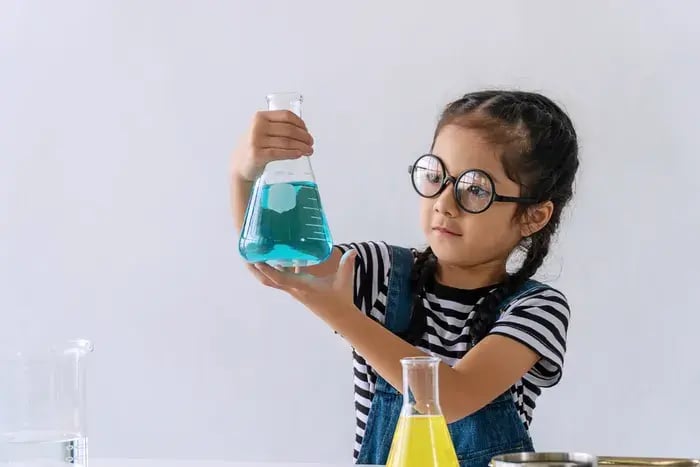Deepali Verma is a senior food and wellness writer with over a decade of experience in top media houses, crafting engaging narratives. She is a professional home baker and loves exploring food from every corner of the world to reading cookbooks. She believes a healthy lifestyle is a combination of mental, spiritual and physical fitness. Her goal always remains to keep moving, eating seasonal and practicing gratitude.
- Promotes Problem-Solving Abilities
- Enhances Scientific Curiosity
- Enhances Concentration and Perseverance
- Enhances Hand-Eye Coordination
- Encourages Fun Learning Without Screens
Introduction
Kids love exploring, questioning, and experimenting. Brain games for kids encourage their curiosity, thus making learning enjoyable and enhancing the problem-solving capabilities of the kid. Science experiments are a combination of fun and education, keeping the child engrossed and providing hands-on experiences that would stimulate critical thinking. These exercises teach patience, observation, and logical reasoning and keep the children engaged. Whether in the home or classroom, DIY science experiments help children understand basic scientific concepts through play. Here are some exciting brain games for kids that nurture creativity and curiosity while making science fun and interactive.
Magic Milk Experiment

This is a very simple science experiment that demonstrates chemical reactions using milk, food coloring, and dish soap. Kids add drops of food coloring to a plate of milk and then introduce dish soap. The colors swirl and mix, showing the effect of soap breaking down fats. This activity encourages observation and scientific reasoning while sparking curiosity about chemical interactions.
Balloon Rocket Race
A fun way to learn about air pressure and propulsion, this game involves attaching a balloon to a string and letting it race forward when released. Kids will understand Newton’s third law of motion while experimenting with different balloon sizes and air pressure levels. This hands-on approach helps build problem-solving and analytical thinking skills.
The Walking Water Experiment
This colorful experiment shows kids the magic of capillary action. Placing strips of paper towels between cups of colored water, water can be made to "walk" from one cup to the other. These concepts of absorption, cohesion, and liquid movement are introduced through this brain game for kids in an interesting manner.
DIY Lava Lamp
With oil, water, food coloring, and effervescent tablets, kids can make their own lava lamp. The oil and water mix are a good demonstration of density differences, and the fizzing tablet releases gas that makes bubbles go up and down. This fun activity promotes creative thinking and observational skills.
Invisible Ink Messages
Using lemon juice as invisible ink, kids can write messages that only appear when heated. This simple science trick demonstrates oxidation and acid-base reactions. This brain game for kids enhances their understanding of chemical changes while offering a fun way to communicate secret messages.
Static Electricity Butterfly

Kids learn about static electricity by running a balloon across their hair and using it to make a paper butterfly's wings move. Thereby, this experiment teaches electrical charges in a very hands-on manner and is great for critical thinking and observational skills.
5 Advantages of Brain Games for Children
Promotes Problem-Solving Abilities
Brain games for kids require them to think critically and find creative solutions. Whether figuring out how to balance an experiment or making predictions, they develop strong problem-solving abilities that extend to real-life situations.
Enhances Scientific Curiosity
DIY science experiments foster interest for discovery. Kids learn to ask questions, make hypotheses, and test their ideas, helping them develop an investigative mindset that supports their overall learning.
Enhances Concentration and Perseverance
Science experiments usually demand careful observation and patience. Waiting for a reaction to happen or adjusting variables to see different results teaches kids the value of perseverance and attention to detail.
Enhances Hand-Eye Coordination
Most brain games for kids involve hands-on activities like pouring, mixing, and assembling materials. These actions strengthen their fine motor skills, hand-eye coordination, and ability to manipulate objects effectively.
Encourages Fun Learning Without Screens

Interactive science experiments give kids a chance to eliminate screen time while keeping the brains agile. It ensures fun learning and creativity with hands-on practical activities that can make education informative and energizing.
The views expressed are that of the expert alone.
The information provided in this content is for informational purposes only and should not be considered a substitute for professional medical advice, diagnosis, or treatment. Always seek the advice of your physician or another qualified healthcare provider before making any significant changes to your diet, exercise, or medication routines.
References
https://www.whatdowedoallday.com/brain-games-for-kids/
https://faculty.washington.edu/chudler/chgames.html
https://www.goodhousekeeping.com/life/parenting/g32176446/science-experiments-for-kids/










